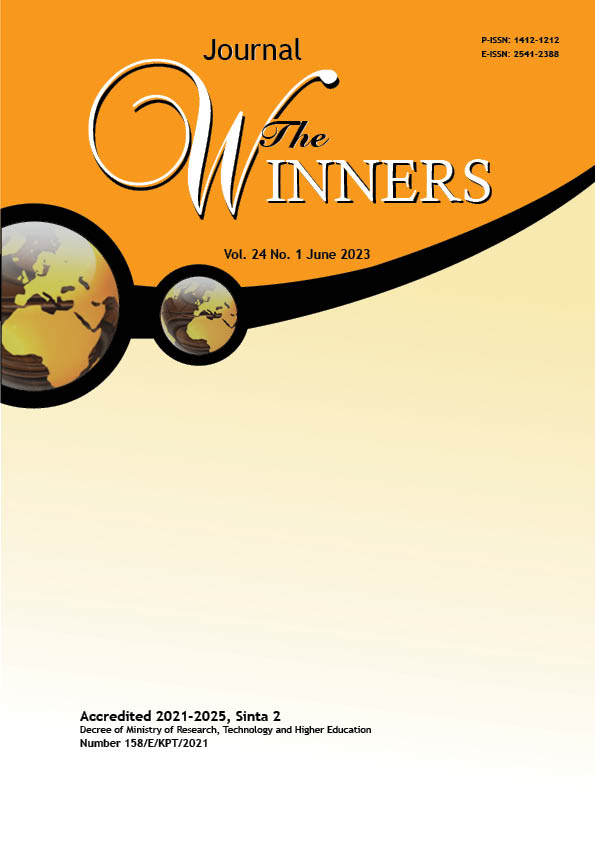The Role of External Auditor in the Adoption of Computer-Assisted Audit Techniques with Unified Theory of Acceptance and Use of Technology: An Empirical Study in Public Audit Firms in Jakarta
DOI:
https://doi.org/10.21512/tw.v24i1.8124Keywords:
CAATs, public audit firms, UTAUT, audit softwareAbstract
The research aimed to analyze factors that influence acceptance of Computer Assisted Audit Techniques (CAATs) among external auditors in Public Audit Firms in Jakarta. The Unified Theory of Acceptance and Use of Technology (UTAUT) approach was used for this analysis. Technological advancements had an effect on auditors' ability to adopt audit software. However, it had been found that there was no preparation or openness from auditors, leading to suboptimal utilization of audit implementation software and affected the presentation of audit information. This investigation adopted a quantitative method by distributing close-ended questionnaires to external auditors in audit firms in Jakarta. Data were analyzed using Partial Least Square with SmartPLS Ver 3. The results show that social influence affected behavioral intention of external auditors in Jakarta in adopting and using CAATs. Expectancy performance, effort expectancy, and facilitating conditions do not affect behavioral intention of external auditors in adopting and using CAATs. The research generates contributions that can be further directed toward the development of auditors’ competencies in optimizing technology in audit.
References
Al-Hiyari, A., Al Said, N., & Hattab, E. (2019). Factors that influence the use of computer assisted audit techniques (CAATs) by internal auditors in Jordan.Academy of Accounting and Financial Studies Journal, 23(3).
Al-Matari, O. M. M., Helal, I. M. A., Mazen, S. A., & Elhennawy, S. (2021). Integrated framework for cybersecurity auditing. Information Security Journal, 30(4), 189-204. https://doi.org/10.1080/19393555.2020.1834649.
Al-Okaily, A., Al-Okaily, M., Shiyyab, F., & Masadah, W. (2020). Accounting information system effectiveness from an organizational perspective. Management Science Letters, 10, 3991-4000. https://doi. org/10.5267/j.msl.2020.7.010.
Alles, M. G. (2015). Drivers of the use and facilitators and obstacles of the evolution of big data by the audit profession. Accounting Horizons, 29(2), 439-449. https://doi.org/10.2308/acch-51067.
Arens, A. A., Elder, R. J., & Beasley, M. S. (2014). Auditing and assurance services: An integrated approach (15th Ed.). Singapore: Pearson
Astolfi, P. (2021). Did the international financial reporting standards increase the audit expectation gap? An exploratory study. Accounting in Europe, 18(2), 166-195. https://doi.org/10.1080/17449480.2020.1865549.
Autor, D. H. (2015). Why are there still so many jobs? The history and future of workplace automation. Journal of Economic Perspectives, 29(3), 3-30. https://doi. org/10.1257/jep.29.3.3.
Behzadian, F. & Nia, N. I. (2017). An investigation of expectation gap between independent auditors and users from auditing services related to the quality of auditing services based on their role and professional features. Asian Journal of Accounting Research, 2(2), 36-47. https://doi.org/10.1108/AJAR-2017-02-02-B005.
Bierstaker, J., Janvrin, D., & Lowe, D. J. (2014). What factors influence auditors’ use of computer-assisted audit techniques? Advances in Accounting, 30(1), 67-74. https://doi.org/10.1016/j.adiac.2013.12.005.
Bowen, G. A. (2009). Document analysis as a qualitative research method. Qualitative Research Journal, 9(2), 27-40. https://doi.org/10.3316/QRJ0902027.
Calderon, T. G. & Gao, L. (2021). Cybersecurity risks disclosure and implied audit risks: Evidence from audit fees. International Journal of Auditing, 25(1), 24-39. https://doi.org/10.1111/ijau.12209.
Chatterjee, S., Rana, N. P., Dwivedi, Y. K., & Baabdullah, A. M. (2021). Understanding AI adoption in manufacturing and production firms using an integrated TAM-TOE model. Technological Forecasting and Social Change, 170. https://doi. org/10.1016/j.techfore.2021.120880.
Chin, W. W. (1998). The partial least squares approach to structural equation modeling. In G. A. Marcoulides, Modern Methods for Business Research, (pp. 295- 336). London: Lawrence Erlbaum Associates.
Deepal, A. G. & Jayamaha, A. (2022). Audit expectation gap: A comprehensive literature review. Asian Journal of Accounting Research, 7(3), 308-319. https://doi.org/10.1108/AJAR-10-2021-0202.
Gepp, A., Linnenluecke, M. K., O’Neill, T. J., & Smith, T.(2018). Big data techniques in auditing research and practice: Current trends and future opportunities. Journal of Accounting Literature, 40, 102-115. https://doi.org/10.1016/j.acclit.2017.05.003.
Gonzalez, G. C., Sharma, P. N., & Galletta, D. F. (2012). The antecedents of the use of continuous auditing in the internal auditing context. International Journal of Accounting Information Systems, 13(3), 248-262. https://doi.org/10.1016/j.accinf.2012.06.009.
Gupta, S., Motlagh, M., & Rhyner, J. (2020). The digitalization sustainability matrix: A participatory research tool for investigating digitainability. Sustainability, 12(21). https://doi.org/10.3390/- su12219283.
Hair, J. F., Risher, J. J., Sarstedt, M., & Ringle, C. M. (2019). When to use and how to report the results of PLS-SEM. European Business Review, 31(1), 2-24. https://doi.org/10.1108/EBR-11-2018-0203.
Handoko, B. L., Ariyanto, S., & Warganegara, D. L. (2018). Perception of financial auditor on usage of computer assisted audit techniques. Proceedings - 3rd International Conference on Computational Intelligence and Applications, ICCIA 2018, (July), 235-239. https://doi.org/10.1109/ ICCIA.2018.00052.
ICAEW. (2018). Artificial Intelligence and the future of Accountancy.
Islam, M. S., Farah, N., & Stafford, T. F. (2018). Factors associated with security/cybersecurity audit by internal audit function: An international study. Managerial Auditing Journal, 33(4), 377-409. https://doi.org/10.1108/MAJ-07-2017-1595.
Joshi, A., Kale, S., Chandel, S., & Pal, D. (2015). Likert scale: Explored and explained. British Journal of Applied Science & Technology, 7(4), 396-403. https://doi.org/10.9734/bjast/2015/14975.
Kokina, J. & Davenport, T. H. (2017). The emergence of artificial intelligence: How automation is changing auditing. Journal of Emerging Technologies in Accounting, 14, 115-122. https://doi.org/10.2308/ jeta-51730.
Kolbjørnsrud, V., Amico, R., & Thomas, R. J. (2017). Partnering with Al: How organizations can win over skeptical managers. Strategy and Leadership, 45(1), 37-43. https://doi.org/10.1108/SL-12-2016-0085.
Krahel, J. P. & Titera, W. R. (2015). Consequence of big data and formalization on accounting and auditing standards. Accounting Horizons, 29(2), 409-422. https://doi.org/10.2308/acch-51065.
Kroon, N., do Céu Alves, M., & Martins, I. (2021). The impacts of emerging technologies on accountants’ role and skills: Connection to open innovation - A systematic literature review. Journal of Open Innovation: Technology, Market, and Complexity, 7(3), 163. https://doi.org/10.3390/ joitmc7030163.
Mahzan, N. & Lymer, A. (2014). Examining the adoption of computer-assisted audit tools and techniques: Cases of generalized audit software use by internal auditors. Managerial Auditing Journal, 29(4), 327-349. https://doi.org/10.1108/MAJ 05-2013-0877.
Marliana, R. R. (2020). Partial least square-structural equation modeling pada hubungan antara tingkat kepuasan mahasiswa dan kualitas Google Classroom berdasarkan metode Webqual 4.0. Jurnal Matematika, Statistika dan Komputasi, 16(2), 174-186. https:// doi.org/10.20956/jmsk.v16i2.7851.
Mohamed, I. S., Muhammad, N. H., & Rozzani, N. (2019). Auditing and data analytics via Computer Assisted Audit Techniques (CAATs): Determinants of adoption intention among auditors in Malaysia. ACM International Conference Proceeding Series, 35-40. https://doi.org/10.1145/3361758.3361773.
Mohammad, A. A., Kamil, S. B., & Bin Mohd Noor, I. (2017). Factors influencing adoption of Computer Assisted Audit Techniques (CAATs) by external auditors in Jordan. International Journal of Engineering Sciences & Management Research, 4(2), 23-27.
Munoko, I., Brown-Liburd, H. L., & Vasarhelyi, M. (2020). The ethical implications of using artificial intelligence in auditing. Journal of Business Ethics, 167, 209-234. https://doi.org/10.1007/s10551-019- 04407-1.
Muscolino, H., Koh, R., Alexa, J., Anderson, C., Bigliani, R., Buttita, M., …, Wang, A. (2020). IDC FutureScape: Worldwide Future of Work 2020 Predictions. IDC, October 2019, 1–21. https://idc-cema.com/ dwn/SF_280618/future_of_work_2020_top_10_ predictions.pdf
Najafabadi, M. M., Villanustre, F., Khoshgoftaar, T. M., Seliya, N., Wald, R., & Muharemagic, E. (2015). Deep learning applications and challenges in big data analytics. Journal of Big Data, 2(1), 1-21. https://doi.org/10.1186/s40537-014-0007-7.
Prasetyo, Y. T., Ong, A. K. S., Concepcion, G. K. F., Navata, F. M. B., Robles, R. A. V., Tomagos, I. J. T., …, & Redi, A. A. N. P. (2021). Determining factors affecting acceptance of e-learning platforms during the Covid-19 pandemic: Integrating extended technology acceptance model and delone & mclean is success model. Sustainability (Switzerland), 13(15).https://doi.org/10.3390/su13158365.
Raguseo, E. (2018). Big data technologies: An empirical investigation on their adoption, benefits and risks for companies. International Journal of Information Management, 38(1), 187-195. https:// doi.org/10.1016/j.ijinfomgt.2017.07.008.
Rezaee, Z. & Wang, J. (2019). Relevance of big data to forensic accounting practice and education. Managerial Auditing Journal, 34(3), 268-288. https://doi.org/10.1108/MAJ-08-2017-1633.
Rosati, P., Gogolin, F., & Lynn, T. (2019). Audit firm assessments of cyber-security risk: Evidence from audit fees and SEC comment letters. International Journal of Accounting, 54(3). https://doi. org/10.1142/S1094406019500136.
Salijeni, G., Samsonova-Taddei, A., & Turley, S. (2019). Big data and changes in audit technology: Contemplating a research agenda. Accounting and Business Research, 49(1), 95-119. https://doi.org/10.1080/00014788.2018.1459458.
Sekaran, U. & Bougie, R. (2016). Research Method for Business Textbook (A Skill Building Approach). United States: John Wiley & Sons Inc.
Shamsuddin, A., Rajasharen, L., Maran, D., Ameer, M. F. M., & Muthu, P. M. (2015). Factors influencing usage level of Computer Assisted Audit Teachniques (CAATs) by internal auditors in Malaysia. Kuala Lumpur International Business, Economics and Law Conference, 6(1), 123-131.
Shihab, M. R., Meilatinova, N., Hidayanto,A. N., & Herkules. (2017). Determinants of CAATT acceptance: Insights from public accounting firms in Indonesia. Procedia Computer Science, 124, 522-529. https:// doi.org/10.1016/j.procs.2017.12.185.
Siew, E. G., Rosli, K., & Yeow, P. H. P. (2020). Organizational and environmental influences in the adoption of computer-assisted audit tools and techniques (CAATTs) by audit firms in Malaysia. International Journal of Accounting Information Systems 36(C). https://doi.org/10.1016/j.accinf.2019.100445.
Sirois, L.-P., Marmousez, S., & Simunic, D. A. (2016). Auditor size and audit quality revisited: The importance of audit technology. Accounting Auditing Control, 22(3), 111-144. https://doi.org/10.3917/ cca.223.0111.
SlapniÄar, S., Vuko, T., ÄŒular, M., & DraÅ¡Äek, M. (2022). Effectiveness of cybersecurity audit. International Journal of Accounting Information Systems, 44, 1-21. https://doi.org/10.1016/j.accinf.2021.100548.
Sugiyono. (2015). Metode penelitian kombinasi (mix methods). Bandung: Alfabeta.
Sutanto, S., Ghozali, I., & Handayani, R. S. (2018). Faktor-faktor yang memengaruhi penerimaan dan penggunaan Sistem Informasi Pengelolaan Keuangan Daerah (SIPKD) dalam perspektif the Unified Theory of Acceptance and Use of Technology 2 (Utaut 2) di Kabupaten Semarang. Jurnal Akuntansi dan Auditing, 15(1), 37. https:// doi.org/10.14710/jaa.15.1.37-68
Venkatesh, V., Morris, M. G., Davis, G. B., & Davis, F. D. (2003). User acceptance of information technology: Toward a unified view. MIS Quarterly, 27(3), 425-478. https://doi.org/10.1006/mvre.1994.1019.
Weyant, E. (2022). Research design: Qualitative, quantitative, and mixed methods approaches, 5th Edition. Journal of Electronic Resources in Medical Libraries, 19(1-2), 54-55. https://doi.org/10.1080/15424065.2022.2046231.
Widuri, R., O’Connell, B., & Yapa, P. W. S. (2016). Adopting generalized audit software: An Indonesian perspective. Managerial Auditing Journal, 31(8/9), 821-847. https://doi.org/https://doi.org/10.1108/ MAJ-10-2015-1247.
Zadorozhnyi, Z.-M., Muravskyi, V., Shevchuk, O., & Bryk, M. (2021). Innovative accounting methodology of ensuring the interaction of economic and cybersecurity of enterprises. Marketing and Management of Innovations, 4, 36-46. https://doi. org/10.21272/mmi.2021.4-03.
Downloads
Published
How to Cite
Issue
Section
License
Copyright (c) 2023 Kevin Deniswara, Thomas Henky, Archie Nathanael Mulyawan; Wishnu Kameshwara Armand; Mazlina Mustapha

This work is licensed under a Creative Commons Attribution-ShareAlike 4.0 International License.
Authors who publish with this journal agree to the following terms:
a. Authors retain copyright and grant the journal right of first publication with the work simultaneously licensed under a Creative Commons Attribution License - Share Alike that allows others to share the work with an acknowledgment of the work's authorship and initial publication in this journal.
b. Authors are able to enter into separate, additional contractual arrangements for the non-exclusive distribution of the journal's published version of the work (e.g., post it to an institutional repository or publish it in a book), with an acknowledgment of its initial publication in this journal.
c. Authors are permitted and encouraged to post their work online (e.g., in institutional repositories or on their website) prior to and during the submission process, as it can lead to productive exchanges, as well as earlier and greater citation of published work.
USER RIGHTS
All articles published Open Access will be immediately and permanently free for everyone to read and download. We are continuously working with our author communities to select the best choice of license options, currently being defined for this journal as follows: Creative Commons Attribution-Share Alike (CC BY-SA)

















